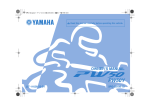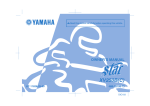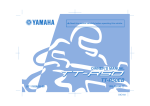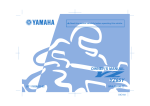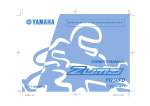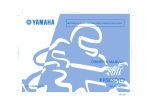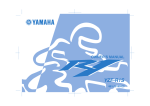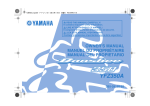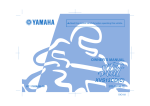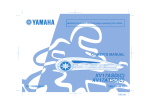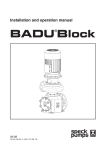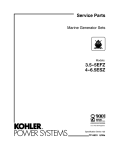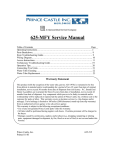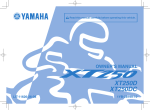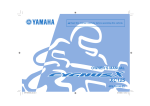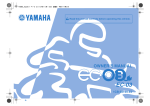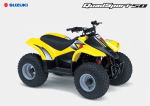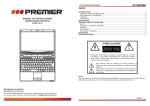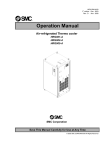Download User Manual PDF
Transcript
Read this manual carefully before operating this vehicle.
Il convient de lire attentivement ce manuel avant la première utilisation du véhicule.
Bitte lesen Sie diese Bedienungsanleitung sorgfältig
durch, bevor Sie das Fahrzeug in Betrieb nehmen.
OWNER’S MANUAL
MANUEL DU PROPRIÉTAIRE
BEDIENUNGSANLEITUNG
PW50
PW50D
PW50D1
5PG-28199-8B
DIC183
Downloaded from www.Manualslib.com manuals search engine
PRINTED ON RECYCLED PAPER
IMPRIMÉ SUR PAPIER RECYCLÉ
AUF RECYCLINGPAPIER GEDRUCKT
PRINTED IN JAPAN
2012.07-0.6×1 CR
(E,F,G)
DIC183
Downloaded from www.Manualslib.com manuals search engine
U5PG8BE0.book Page 1 Wednesday, June 27, 2012 2:53 PM
Read this manual carefully before operating this vehicle.
OWNER’S MANUAL
PW50
PW50D
PW50D1
5PG-28199-8B-E0
Downloaded from www.Manualslib.com manuals search engine
U5PG8BE0.book Page 1 Wednesday, June 27, 2012 2:53 PM
EAU48173
Read this manual carefully before operating this vehicle. This manual should stay with this vehicle if it is sold.
EC Declaration of Conformity
conforming to Directive 2006/42/EC
We, YAMAHA MOTOR CO., LTD. 2500 Shingai, Iwata, Japan,
declare in sole responsibility, that the product
PW50
(JYA3PT00000428377– )
(Make, model)
to which this declaration applies, conforms to the essential health
and safety requirements of Directive 2006/42/EC
(If applicable)
and to the other relevant Directives of EEC
2004/108/EC
(Title and/or number and date of issue of the other Directives of EEC)
(If applicable)
To effect correct application of the essential health and safety requirements
stated in the Directives of EEC, the following-standards and/or technical
specifications were consulted:
EN16029
(Title and/or number and date of issue of standards and/or specifications)
Authorized Representative
YAMAHA MOTOR EUROPE N.V.
Koolhovenlaan 101, 1119 NC Schiphol-Rijk, The Netherlands
Signature
Hiromi Yamamoto
General Manager.
Development Division
3rd Business Unit
Motorcycle Business Operations
YAMAHA MOTOR CO., LTD.
Date of Issue
16 May , 2012
Downloaded from www.Manualslib.com manuals search engine
U5PG8BE0.book Page 1 Wednesday, June 27, 2012 2:53 PM
INTRODUCTION
EAU41074
Congratulations on your purchase of the Yamaha PW50/PW50D/PW50D1. This model is the result of Yamaha’s vast experience in the production of fine sporting, touring, and pacesetting racing machines. It represents the high degree of craftsmanship and reliability that have made Yamaha a leader in these fields.
This manual will give you an understanding of the operation, inspection, and basic maintenance of this motorcycle. If you
have any questions concerning the operation or maintenance of your motorcycle, please consult a Yamaha dealer.
The design and manufacture of this Yamaha motorcycle fully comply with the emissions standards for clean air applicable at
the date of manufacture. Yamaha has met these standards without reducing the performance or economy of operation of the
motorcycle. To maintain these high standards, it is important that you and your Yamaha dealer pay close attention to the
recommended maintenance schedules and operating instructions contained within this manual.
Yamaha continually seeks advancements in product design and quality. Therefore, while this manual contains the most current product information available at the time of printing, there may be minor discrepancies between your motorcycle and this
manual. If there is any question concerning this manual, please consult a Yamaha dealer.
EWA10031
WARNING
Please read this manual carefully and completely before operating this motorcycle.
EWA14351
WARNING
This motorcycle is designed and manufactured for off-road use only. It is illegal to operate this motorcycle on any
public street, road or highway. Such use is prohibited by law. This motorcycle complies with almost all state offhighway noise level and spark arrester laws and regulations. Please check your local riding laws and regulations
before operating this motorcycle.
AN IMPORTANT SAFETY MESSAGE:
● Read this manual carefully and completely before operating this motorcycle. Make sure you understand all instructions.
● Pay close attention to the warning and notice labels on the motorcycle.
● Never operate a motorcycle without proper training or instruction.
● Weight of the rider should not exceed 25 kg (55 lb).
Downloaded from www.Manualslib.com manuals search engine
U5PG8BE0.book Page 2 Wednesday, June 27, 2012 2:53 PM
INTRODUCTION
AN IMPORTANT NOTE TO PARENTS:
This motorcycle is not a toy. Before you let your child ride this motorcycle, you should understand the instructions and warnings in this Owner’s Manual. Then be sure your child understands and will follow them. Children differ in skills, physical abilities, and judgment. Some children may not be able to operate a motorcycle safely. Parents should supervise their child’s
use of the motorcycle at all times. Parents should permit continued use only if they determine that the child has the ability to
operate the motorcycle safely.
Your motorcycle is equipped with an adjustable speed limiter and a power reduction plate. Yamaha recommends that all beginners start off with the speed limiter adjusting screw turned in and the power reduction plate installed in the exhaust manifold to limit the power available while they learn. The limiter screw may be gradually turned out to increase maximum speed
as the beginner becomes more familiar with operating the motorcycle. Parents should decide when to adjust the motorcycle
for more power as their youngster’s riding skills improve. Once the rider can operate with skill at the top speed permitted by
adjusting the speed limiter alone, the power reduction plate can be removed. Since removal of this plate will result in a significant increase in power, turn the speed limiter back in again; adjust it out in stages as you did before.
Motorcycles are single track vehicles. Their safe use and operation are dependent upon the use of proper riding
techniques as well as the expertise of the operator. Every operator should know the following requirements before
riding this motorcycle.
He or she should:
● Obtain thorough instructions from a competent source on all aspects of motorcycle operation.
● Observe the warnings and maintenance requirements in this Owner’s Manual.
● Obtain qualified training in safe and proper riding techniques.
● Obtain professional technical service as indicated in this Owner’s Manual and/or when made necessary by mechanical
conditions.
Downloaded from www.Manualslib.com manuals search engine
U5PG8BE0.book Page 1 Wednesday, June 27, 2012 2:53 PM
IMPORTANT MANUAL INFORMATION
EAU10133
Particularly important information is distinguished in this manual by the following notations:
This is the safety alert symbol. It is used to alert you to potential personal injury
hazards. Obey all safety messages that follow this symbol to avoid possible injury
or death.
WARNING
NOTICE
TIP
A WARNING indicates a hazardous situation which, if not avoided, could result in
death or serious injury.
A NOTICE indicates special precautions that must be taken to avoid damage to the
vehicle or other property.
A TIP provides key information to make procedures easier or clearer.
*Product and specifications are subject to change without notice.
Downloaded from www.Manualslib.com manuals search engine
U5PG8BE0.book Page 2 Wednesday, June 27, 2012 2:53 PM
IMPORTANT MANUAL INFORMATION
EAU10200
PW50/PW50D/PW50D1
OWNER’S MANUAL
©2012 by Yamaha Motor Co., Ltd.
1st edition, June 2012
All rights reserved.
Any reprinting or unauthorized use
without the written permission of
Yamaha Motor Co., Ltd.
is expressly prohibited.
Printed in Japan.
Downloaded from www.Manualslib.com manuals search engine
U5PG8BE0.book Page 1 Wednesday, June 27, 2012 2:53 PM
TABLE OF CONTENTS
LOCATION OF IMPORTANT
LABELS ............................................1-1
FOR YOUR SAFETY –
PRE-OPERATION CHECKS ............. 5-1
SAFETY INFORMATION ..................2-1
OPERATION AND IMPORTANT
RIDING POINTS ................................ 6-1
Starting and warming up
a cold engine .............................. 6-1
Starting a warm engine .................. 6-1
Starting off ..................................... 6-2
Acceleration and deceleration ....... 6-2
Braking ........................................... 6-2
Engine break-in .............................. 6-3
Parking ........................................... 6-4
DESCRIPTION ..................................3-1
Left view ..........................................3-1
Right view ........................................3-2
Controls and instruments ................3-3
INSTRUMENT AND CONTROL
FUNCTIONS .......................................4-1
Handlebar switch ............................4-1
Speed limiter and power reduction
plate ............................................4-1
Front brake lever ............................4-2
Rear brake lever .............................4-3
Fuel tank cap ..................................4-3
Fuel ................................................4-3
Fuel tank breather hose .................4-5
2-stroke engine oil ..........................4-6
Fuel cock ........................................4-6
Starter (choke) lever .......................4-7
Kickstarter ......................................4-7
Seat ................................................4-7
Cable lock (for Europe) ..................4-8
Downloaded from www.Manualslib.com manuals search engine
PERIODIC MAINTENANCE AND
ADJUSTMENT................................... 7-1
Owner’s tool kit .............................. 7-2
Periodic maintenance chart for
the emission control system ....... 7-3
General maintenance and
lubrication chart .......................... 7-4
Checking the spark plug ................ 7-6
Removing the power reduction
plate ............................................ 7-7
Transmission oil ............................. 7-8
Middle and final gear cases ........... 7-9
Cleaning the air filter element ........ 7-9
Cleaning the spark arrester ......... 7-10
Adjusting the carburetor ............... 7-11
Adjusting the engine idling
speed ........................................ 7-11
Checking the throttle grip free
play ........................................... 7-12
Tires ............................................. 7-12
Panel wheels ................................ 7-14
Adjusting the front and
rear brake lever free play .......... 7-14
Checking the front and
rear brake shoes ....................... 7-15
Checking and lubricating
the cables ................................. 7-16
Checking and lubricating
the throttle grip and cable ......... 7-16
Adjusting the Autolube pump ....... 7-16
Lubricating the front and
rear brake levers ....................... 7-17
Checking and lubricating
the centerstand ......................... 7-17
Checking the front fork ................. 7-17
Checking the steering .................. 7-18
Checking the wheel bearings ....... 7-18
Front wheel .................................. 7-19
Rear wheel ................................... 7-20
Troubleshooting ........................... 7-23
Troubleshooting chart .................. 7-24
MOTORCYCLE CARE AND
STORAGE .......................................... 8-1
Matte color caution ......................... 8-1
Care ............................................... 8-1
Storage ........................................... 8-3
U5PG8BE0.book Page 2 Wednesday, June 27, 2012 2:53 PM
TABLE OF CONTENTS
SPECIFICATIONS .............................9-1
CONSUMER INFORMATION...........10-1
Identification numbers ..................10-1
Downloaded from www.Manualslib.com manuals search engine
U5PG8BE0.book Page 1 Wednesday, June 27, 2012 2:53 PM
LOCATION OF IMPORTANT LABELS
EAU48115
Read and understand all of the labels on your vehicle. They contain important information for safe and proper operation of
your vehicle. Never remove any labels from your vehicle. If a label becomes difficult to read or comes off, a replacement label
is available from your Yamaha dealer.
For Canada
1
2
3,4
7
5,6
1-1
Downloaded from www.Manualslib.com manuals search engine
1
U5PG8BE0.book Page 2 Wednesday, June 27, 2012 2:53 PM
LOCATION OF IMPORTANT LABELS
For Canada
1
2
WARNING
• CMVSS
ANADA •
•C
VAC •
NS
• BEFORE YOU OPERATE THIS VEHICLE, READ THE OWNER’S
MANUAL AND ALL LABELS.
• NEVER CARRY A PASSENGER. You increase your risk of losing
control if you carry a passenger.
• NEVER OPERATE THIS VEHICLE ON PUBLIC ROADS. You can
collide with another vehicle if you operate this vehicle on a public road.
• ALWAYS WEAR AN APPROVED MOTORCYCLE HELMET,
eye protection, and protective clothing.
506
T
RA
T
1
NSPO
R
3PT-2118K-A1
3
4
THIS VEHICLE IS A RESTRICTED USE
MOTORCYCLE AND IS NOT INTENDED FOR
USE ON PUBLIC HIGHWAYS.
CE VÉHICULE EST UNE MOTOCYCLETTE À
USAGE RESTREINT DONT L’USAGE N’EST PAS
DESTINÉ AUX VOIES PUBLIQUES.
AVERTISSEMENT
• LIRE LE MANUEL DU PROPRIETAIRE AINSI QUE TOUTES LES
ETIQUETTES AVANT D’UTILISER CE VEHICULE.
• NE JAMAIS TRANSPORTER DE PASSAGER. La conduite avec
passager augmente les risques de perte de contrôle.
• NE JAMAIS ROULER SUR DES CHEMINS PUBLICS.
Vous pourriez entrer en collision avec un autre véhicule.
• TOUJOURS PORTER UN CASQUE DE MOTOCYCLISTE
APPROUVE, des lunettes et des vêtements de protection.
3PT-2416E-10
5PG-2118K-10
1-2
Downloaded from www.Manualslib.com manuals search engine
U5PG8BE0.book Page 3 Wednesday, June 27, 2012 2:53 PM
LOCATION OF IMPORTANT LABELS
For Canada
5
6
1
TIRE INFORMATION
INFORMATION SUR LES PNEUS
Cold tire nor mal pressure should be set as
follows.
FRO NT : 1 0 0 kPa, {1 .00 k gf /c m²}, 1 5 ps i
RE AR : 1 0 0 kPa, {1 .00 k gf /c m²}, 1 5 ps i
La pression des pneus à froid doit normalement
être réglée comme suit.
AVANT : 100 kPa, { 1. 00 kg f/cm ²} , 15 psi
ARRIERE : 100 kPa, { 1. 00 kg f/cm ²} , 15 psi
3RV-21668-A0
3RV-21668-B0
7
This spark ignition system meets all requirements
of the Canadian Interference Causing Equipment
Regulations.
Ce système d’allumage par étincelle de véhicule
respecte toutes les exigences du Règlement sur le
matériel brouilleur du Canada.
3JK-82377-00
1-3
Downloaded from www.Manualslib.com manuals search engine
U5PG8BE0.book Page 4 Wednesday, June 27, 2012 2:53 PM
LOCATION OF IMPORTANT LABELS
For Europe
1
1
2
4
3
1-4
Downloaded from www.Manualslib.com manuals search engine
U5PG8BE0.book Page 5 Wednesday, June 27, 2012 2:53 PM
LOCATION OF IMPORTANT LABELS
For Europe
1
2
1
PW50
2.1 kW
39 kg
5PG-2156A-10
5B6-2816R-00
3
4
EN16029
2012
YAMAHA MOTOR CO., LTD.
2500 SHINGAI, IWATA, JAPAN
100 kPa
100 kPa
1.00 kgf/cm² 1.00 kgf/cm²
15 psi
15 psi
5B6-2817L-00
5PG-2816R-00
1-5
Downloaded from www.Manualslib.com manuals search engine
U5PG8BE0.book Page 6 Wednesday, June 27, 2012 2:53 PM
LOCATION OF IMPORTANT LABELS
Familiarize yourself with the following pictograms and read the explanatory text.
1
Read the Owner’s manual.
Never use on paved roads.
Always use an approved
helmet and protective gear.
Never carry passengers.
Use from 6 years old.
Operation of this motorcycle
by children under the age of 6
increase the risk of severe
injury or death.
This unit contains highpressure nitrogen gas.
Mishandling can cause an
explosion. Do not incinerate,
puncture or open.
Adult supervision required for
children.
Turn off the main switch after
riding to avoid draining the
battery.
1-6
Downloaded from www.Manualslib.com manuals search engine
U5PG8BE0.book Page 7 Wednesday, June 27, 2012 2:53 PM
LOCATION OF IMPORTANT LABELS
Use unleaded gasoline only.
1
1
****
YAMAHA MOTOR CO., LTD.
2500 SHINGAI, IWATA, JAPAN
Measure the tire pressure
when the tires are cold.
**.* kPa
*.** kgf/cm²
*.* psi
**.* kPa
*.** kgf/cm²
*.* psi
1
******
*** kW *** kg
2
3
Adjust the tire pressure.
Improper tire pressure can
cause loss of control.
Loss of control can result in
severe injury or death.
1 Model Name
2 Max. Power
3 Mass In Running Order
1-7
Downloaded from www.Manualslib.com manuals search engine
1 Year of construction
U5PG8BE0.book Page 8 Wednesday, June 27, 2012 2:53 PM
LOCATION OF IMPORTANT LABELS
For Oceania and South Africa
1
1
2
1-8
Downloaded from www.Manualslib.com manuals search engine
U5PG8BE0.book Page 9 Wednesday, June 27, 2012 2:53 PM
LOCATION OF IMPORTANT LABELS
For Oceania and South Africa
1
2
WARNING
• BEFORE YOU OPERATE THIS VEHICLE, READ THE OWNER’S
MANUAL AND ALL LABELS.
• NEVER CARRY A PASSENGER. You increase your risk of losing
control if you carry a passenger.
• NEVER OPERATE THIS VEHICLE ON PUBLIC ROADS. You can
collide with another vehicle if you operate this vehicle on a public road.
• ALWAYS WEAR AN APPROVED MOTORCYCLE HELMET,
eye protection, and protective clothing.
Cold tire normal pressure should be set as
follows.
F RON T : 100 kPa, { 1. 00 kg f/cm ²} , 15 psi
RE AR : 100 kPa, { 1. 00 kg f/cm ²} , 15 psi
3RV-21668-A0
3PT-2118K-A1
1-9
Downloaded from www.Manualslib.com manuals search engine
1
TIRE INFORMATION
U5PG8BE0.book Page 1 Wednesday, June 27, 2012 2:53 PM
SAFETY INFORMATION
EAU4093B
2
Be a Responsible Owner
As the vehicle’s owner, you are responsible for the safe and proper operation
of your motorcycle.
Motorcycles are single-track vehicles.
Their safe use and operation are dependent upon the use of proper riding
techniques as well as the expertise of
the operator. Every operator should
know the following requirements before
riding this motorcycle.
He or she should:
● Obtain thorough instructions from
a competent source on all aspects
of motorcycle operation.
● Observe the warnings and maintenance requirements in this Owner’s Manual.
● Obtain qualified training in safe
and proper riding techniques.
● Obtain professional technical service as indicated in this Owner’s
Manual and/or when made necessary by mechanical conditions.
●
Never operate a motorcycle without proper training or instruction.
Take a training course. Beginners
should receive training from a certified instructor. Contact an authorized motorcycle dealer to find out
about the training courses nearest
you.
Safe Riding
Perform the pre-operation checks each
time you use the vehicle to make sure it
is in safe operating condition. Failure to
inspect or maintain the vehicle properly
increases the possibility of an accident
or equipment damage. See page 5-1
for a list of pre-operation checks.
● This motorcycle is designed for offroad use only, therefore, it is illegal
to operate it on public streets,
roads, or highways, even a dirt or
gravel one. Off-road use on public
lands may be illegal. Please check
local regulations before riding.
● This motorcycle is designed to carry the operator only. No passengers.
2-1
Downloaded from www.Manualslib.com manuals search engine
●
The failure of motorists to detect
and recognize motorcycles in traffic is the predominating cause of
automobile/motorcycle accidents.
Many accidents have been caused
by an automobile driver who did
not see the motorcycle. Making
yourself conspicuous appears to
be very effective in reducing the
chance of this type of accident.
Therefore:
• Wear a brightly colored jacket.
• Use extra caution when you are
approaching
and
passing
through intersections, since intersections are the most likely
places for motorcycle accidents
to occur.
• Ride where other motorists can
see you. Avoid riding in another
motorist’s blind spot.
• Never maintain a motorcycle
without proper knowledge. Contact an authorized motorcycle
dealer to inform you on basic
motorcycle maintenance. Certain maintenance can only be
carried out by certified staff.
U5PG8BE0.book Page 2 Wednesday, June 27, 2012 2:53 PM
SAFETY INFORMATION
●
●
●
●
Many accidents involve inexperienced operators.
• Make sure that you are qualified
and that you only lend your motorcycle to other qualified operators.
• Know your skills and limits.
Staying within your limits may
help you to avoid an accident.
• We recommend that you practice riding your motorcycle until
you have become thoroughly familiar with the motorcycle and all
of its controls.
Many accidents have been caused
by error of the motorcycle operator. A typical error made by the operator is veering wide on a turn
due to excessive speed or undercornering (insufficient lean angle
for the speed). Never travel faster
than warranted by conditions.
Ride cautiously in unfamiliar areas. You may encounter hidden
obstacles that could cause an accident.
The posture of the operator is important for proper control. The operator should keep both hands on
●
the handlebar and both feet on the
operator footrests during operation
to maintain control of the motorcycle.
Never ride under the influence of
alcohol or other drugs.
Protective Apparel
The majority of fatalities from motorcycle accidents are the result of head injuries. The use of a safety helmet is the
single most critical factor in the prevention or reduction of head injuries.
● Always wear an approved helmet.
● Wear a face shield or goggles.
Wind in your unprotected eyes
could contribute to an impairment
of vision that could delay seeing a
hazard.
● The use of a jacket, heavy boots,
trousers, gloves, etc., is effective in
preventing or reducing abrasions
or lacerations.
● Never wear loose-fitting clothes,
otherwise they could catch on the
control levers, footrests, or wheels
and cause injury or an accident.
2-2
Downloaded from www.Manualslib.com manuals search engine
●
Always wear protective clothing
that covers your legs, ankles, and
feet. The engine or exhaust system become very hot during or after operation and can cause burns.
Avoid Carbon Monoxide Poisoning
All engine exhaust contains carbon
monoxide, a deadly gas. Breathing carbon monoxide can cause headaches,
dizziness, drowsiness, nausea, confusion, and eventually death.
Carbon Monoxide is a colorless, odorless, tasteless gas which may be
present even if you do not see or smell
any engine exhaust. Deadly levels of
carbon monoxide can collect rapidly
and you can quickly be overcome and
unable to save yourself. Also, deadly
levels of carbon monoxide can linger
for hours or days in enclosed or poorly
ventilated areas. If you experience any
symptoms of carbon monoxide poisoning, leave the area immediately, get
fresh air, and SEEK MEDICAL TREATMENT.
2
U5PG8BE0.book Page 3 Wednesday, June 27, 2012 2:53 PM
SAFETY INFORMATION
●
2
●
●
Do not run engine indoors. Even if
you try to ventilate engine exhaust
with fans or open windows and
doors, carbon monoxide can rapidly reach dangerous levels.
Do not run engine in poorly ventilated or partially enclosed areas
such as barns, garages, or carports.
Do not run engine outdoors where
engine exhaust can be drawn into
a building through openings such
as windows and doors.
Loading
Adding accessories to your motorcycle
can adversely affect stability and handling if the weight distribution of the motorcycle is changed. To avoid the
possibility of an accident, use extreme
caution when adding accessories to
your motorcycle. Use extra care when
riding a motorcycle that has added accessories. Here are some general
guidelines to follow if adding accessories to your motorcycle:
Operation of an overloaded vehicle
could cause an accident.
●
●
●
The weight of the operator must
not exceed 25 kg (55 lb).
Accessory weight should be kept
as low and close to the motorcycle
as possible. Securely pack your
heaviest items as close to the center of the vehicle as possible and
make sure to distribute the weight
as evenly as possible on both
sides of the motorcycle to minimize imbalance or instability.
Shifting weights can create a sudden imbalance. Make sure that accessories are securely attached to
the motorcycle before riding.
Check accessory mounts frequently.
• Properly adjust the suspension
for your load (suspension-adjustable models only), and
check the condition and pressure of your tires.
• Never attach any large or heavy
items to the handlebar, front
fork, or front fender.
2-3
Downloaded from www.Manualslib.com manuals search engine
Genuine Yamaha Accessories
Choosing accessories for your vehicle
is an important decision. Genuine
Yamaha accessories, which are available only from a Yamaha dealer, have
been designed, tested, and approved
by Yamaha for use on your vehicle.
Many companies with no connection to
Yamaha manufacture parts and accessories or offer other modifications for
Yamaha vehicles. Yamaha is not in a
position to test the products that these
aftermarket
companies
produce.
Therefore, Yamaha can neither endorse nor recommend the use of accessories not sold by Yamaha or
modifications not specifically recommended by Yamaha, even if sold and
installed by a Yamaha dealer.
Aftermarket Parts, Accessories, and
Modifications
While you may find aftermarket products similar in design and quality to
genuine Yamaha accessories, recognize that some aftermarket accessories
or modifications are not suitable because of potential safety hazards to you
or others. Installing aftermarket prod-
U5PG8BE0.book Page 4 Wednesday, June 27, 2012 2:53 PM
SAFETY INFORMATION
ucts or having other modifications performed to your vehicle that change any
of the vehicle’s design or operation
characteristics can put you and others
at greater risk of serious injury or death.
You are responsible for injuries related
to changes in the vehicle.
Keep the following guidelines in mind,
as well as those provided under “Loading” when mounting accessories.
● Never install accessories that
would impair the performance of
your motorcycle. Carefully inspect
the accessory before using it to
make sure that it does not in any
way reduce ground clearance or
cornering clearance, limit suspension travel, steering travel or control operation.
• Accessories fitted to the handlebar or the front fork area can
create instability due to improper
weight distribution. If accessories are added to the handlebar
or front fork area, they must be
as lightweight as possible and
should be kept to a minimum.
●
• Bulky or large accessories may
seriously affect the stability of
the motorcycle. Wind may attempt to lift the motorcycle, or
the motorcycle may become unstable in cross winds.
• Certain accessories can displace the operator from his or
her normal riding position. This
improper position limits the freedom of movement of the operator and may limit control ability,
therefore, such accessories are
not recommended.
Use caution when adding electrical accessories. If electrical accessories exceed the capacity of the
motorcycle’s electrical system, an
electric failure could result, which
could cause a dangerous loss of
lights or engine power.
Aftermarket Tires and Rims
The tires and rims that came with your
motorcycle were designed to match the
performance capabilities and to provide
the best combination of handling, braking, and comfort. Other tires, rims, sizes, and combinations may not be
2-4
Downloaded from www.Manualslib.com manuals search engine
appropriate. Refer to page 7-12 for tire
specifications and more information on
replacing your tires.
Transporting the Motorcycle
Be sure to observe following instructions before transporting the motorcycle in another vehicle.
● Remove all loose items from the
motorcycle.
● Check that the fuel cock is in the
“S” (stop) position and that there
are no fuel leaks.
● Point the front wheel straight
ahead on the trailer or in the truck
bed, and choke it in a rail to prevent movement.
● Shift the transmission in gear (for
models with a manual transmission).
● Secure the motorcycle with tiedowns or suitable straps that are
attached to solid parts of the motorcycle, such as the frame or upper front fork triple clamp (and not,
for example, to rubber-mounted
handlebars or turn signals, or parts
that could break). Choose the lo-
2
U5PG8BE0.book Page 5 Wednesday, June 27, 2012 2:53 PM
SAFETY INFORMATION
●
2
cation for the straps carefully so
the straps will not rub against
painted surfaces during transport.
The suspension should be compressed somewhat by the tiedowns, if possible, so that the motorcycle will not bounce excessively during transport.
2-5
Downloaded from www.Manualslib.com manuals search engine
U5PG8BE0.book Page 1 Wednesday, June 27, 2012 2:53 PM
DESCRIPTION
EAU10410
Left view
1
2
3
4
3
6
1.
2.
3.
4.
5.
6.
Spark plug (page 7-6)
Fuel cock (page 4-6)
Throttle stop screw (page 7-11)
Air filter element (page 7-9)
Kickstarter (page 4-7)
Centerstand (page 7-17)
3-1
Downloaded from www.Manualslib.com manuals search engine
5
U5PG8BE0.book Page 2 Wednesday, June 27, 2012 2:53 PM
DESCRIPTION
EAU10420
Right view
1
2
3
4
3
5
1.
2.
3.
4.
5.
Spark arrester (page 7-10)
Seat (page 4-7)
Transmission oil filler cap (page 7-8)
2-stroke engine oil tank (page 4-6)
Transmission oil drain bolt (page 7-8)
3-2
Downloaded from www.Manualslib.com manuals search engine
U5PG8BE0.book Page 3 Wednesday, June 27, 2012 2:53 PM
DESCRIPTION
EAU10430
Controls and instruments
1
2
3
4
5
3
7
1.
2.
3.
4.
5.
6.
7.
Rear brake lever (page 4-3)
Starter (choke) lever (page 4-7)
2-stroke engine oil tank cap (page 4-6)
Engine stop switch (page 4-1)
Front brake lever (page 4-2)
Throttle grip (page 7-12)
Fuel tank cap (page 4-3)
3-3
Downloaded from www.Manualslib.com manuals search engine
6
U5PG8BE0.book Page 1 Wednesday, June 27, 2012 2:53 PM
INSTRUMENT AND CONTROL FUNCTIONS
EAU40660
Handlebar switch
1
●
The engine speed is limited while
this switch is set to the “START”
position, therefore the motorcycle
cannot be ridden in that switch position.
4
1. Engine stop switch “OFF/RUN/START”
TIP
The engine cannot be started with
this switch set to the “RUN” position.
4-1
Downloaded from www.Manualslib.com manuals search engine
Your motorcycle is equipped with an
adjustable speed limiter and a power
reduction plate. The speed limiter
keeps the throttle from fully opening,
even when the throttle grip is turned to
the maximum. The power reduction
plate is installed in the exhaust manifold to limit the amount of power available while learning.
Speed limiter
1. Loosen the locknut.
2. To increase the maximum engine
power available and the maximum
speed of the motorcycle, turn the
adjusting screw in direction (a). To
decrease the maximum engine
power available and the maximum
speed of the motorcycle, turn the
adjusting screw in direction (b).
EAU40674
Engine stop switch
“OFF/RUN/START”
Set this switch to “START” before starting the engine. Set this switch to “RUN”
after warming up the engine or before
starting off. Set this switch to “OFF” to
stop the engine.
●
EAU41044
Speed limiter and power reduction plate
U5PG8BE0.book Page 2 Wednesday, June 27, 2012 2:53 PM
INSTRUMENT AND CONTROL FUNCTIONS
1
2
the throttle grip can only be opened approximately halfway. If more power is
required, please consult a Yamaha
dealer.
EAU12901
Front brake lever
1
EWA14631
(b)
(a)
1. Locknut
2. Adjusting screw
3. Tighten the locknut.
1
1. No more than 7 mm (0.28 in)
WARNING
Improper adjustment of the speed
limiter could cause improper throttle
operation. You could lose control,
have an accident or be injured. Do
not turn the adjusting screw out
more than 7 mm (0.28 in) before consulting a Yamaha dealer. Always
make sure the throttle grip free play
is adjusted to 1.5–3.5 mm (0.06–0.14
in). (See page 7-12.)
Power reduction plate
Once the rider can operate with skill at
the top speed permitted by adjusting
the speed limiter alone, the power reduction plate can be removed. (See
page 7-7.)
TIP
The adjusting range of the speed limiter
screw is from the fully turned-in position
to 7 mm (0.28 in) turned out. When the
screw is turned out to 7 mm (0.28 in),
4-2
Downloaded from www.Manualslib.com manuals search engine
4
1. Front brake lever
The front brake lever is located on the
right side of the handlebar. To apply the
front brake, pull this lever toward the
throttle grip.
U5PG8BE0.book Page 3 Wednesday, June 27, 2012 2:53 PM
INSTRUMENT AND CONTROL FUNCTIONS
EAU12951
Rear brake lever
EAU13182
Fuel tank cap
EAU13212
Fuel
Make sure there is sufficient gasoline in
the tank.
1
1
EWA10881
WARNING
Gasoline and gasoline vapors are
extremely flammable. To avoid fires
and explosions and to reduce the
risk of injury when refueling, follow
these instructions.
4
1. Rear brake lever
1. Fuel tank cap
The rear brake lever is located on the
left side of the handlebar. To apply the
rear brake, pull this lever toward the
handlebar grip.
To remove the fuel tank cap, turn it
counterclockwise, and then pull it off.
To install the fuel tank cap, insert it into
the tank opening, and then turn it clockwise.
EWA11091
WARNING
Make sure that the fuel tank cap is
properly closed after filling fuel.
Leaking fuel is a fire hazard.
4-3
Downloaded from www.Manualslib.com manuals search engine
1. Before refueling, turn off the engine and be sure that no one is sitting on the vehicle. Never refuel
while smoking, or while in the vicinity of sparks, open flames, or
other sources of ignition such as
the pilot lights of water heaters and
clothes dryers.
2. Do not overfill the fuel tank. Stop
filling when the fuel reaches the
bottom of the filler tube. Because
fuel expands when it heats up,
heat from the engine or the sun
can cause fuel to spill out of the
fuel tank.
U5PG8BE0.book Page 4 Wednesday, June 27, 2012 2:53 PM
INSTRUMENT AND CONTROL FUNCTIONS
ately. If gasoline spills on your skin,
wash with soap and water. If gasoline spills on your clothing, change
your clothes.
1
2
EAU41983
For Canada
1. Fuel tank filler tube
2. Maximum fuel level
3. Wipe up any spilled fuel immediately. NOTICE: Immediately wipe
off spilled fuel with a clean, dry,
soft cloth, since fuel may deteriorate painted surfaces or plastic
parts. [ECA10071]
4. Be sure to securely close the fuel
tank cap.
EWA15151
WARNING
Gasoline is poisonous and can
cause injury or death. Handle gasoline with care. Never siphon gasoline by mouth. If you should swallow
some gasoline or inhale a lot of gasoline vapor, or get some gasoline in
your eyes, see your doctor immedi-
Recommended fuel:
REGULAR UNLEADED GASOLINE ONLY
Fuel tank capacity:
2.0 L (0.53 US gal, 0.44 Imp.gal)
ECA15590
NOTICE
Use only unleaded gasoline. The use
of leaded gasoline will cause severe
damage to internal engine parts,
such as the piston rings as well as to
the exhaust system.
Your Yamaha engine has been designed to use regular unleaded gasoline with a pump octane number
[(R+M)/2] of 86 or higher, or a research
octane number of 91 or higher. If
knocking (or pinging) occurs, use a
gasoline of a different brand or premi4-4
Downloaded from www.Manualslib.com manuals search engine
um unleaded fuel. Use of unleaded fuel
will extend spark plug life and reduce
maintenance cost.
Gasohol
There are two types of gasohol: gasohol containing ethanol and that containing methanol. Gasohol containing
ethanol can be used if ethanol content
does not exceed 10% (E10). Gasohol
containing methanol is not recommended by Yamaha because it can
cause damage to the fuel system or vehicle performance problems.
For Europe
Recommended fuel:
REGULAR UNLEADED GASOLINE ONLY
Fuel tank capacity:
2.0 L (0.53 US gal, 0.44 Imp.gal)
ECA15590
NOTICE
Use only unleaded gasoline. The use
of leaded gasoline will cause severe
damage to internal engine parts,
such as the piston rings as well as to
the exhaust system.
4
U5PG8BE0.book Page 5 Wednesday, June 27, 2012 2:53 PM
INSTRUMENT AND CONTROL FUNCTIONS
Your Yamaha engine has been designed to use regular unleaded gasoline with a research octane number of
95 or higher. If knocking (or pinging) occurs, use a gasoline of a different brand
or premium unleaded fuel. Use of unleaded fuel will extend spark plug life
and reduce maintenance costs.
For South Africa
or premium unleaded fuel. Use of unleaded fuel will extend spark plug life
and reduce maintenance costs.
EAU13412
Fuel tank breather hose
1
For Oceania
Recommended fuel:
UNLEADED GASOLINE ONLY
Fuel tank capacity:
2.0 L (0.53 US gal, 0.44 Imp.gal)
4
ECA15590
Recommended fuel:
REGULAR UNLEADED GASOLINE ONLY
Fuel tank capacity:
2.0 L (0.53 US gal, 0.44 Imp.gal)
ECA15590
NOTICE
Use only unleaded gasoline. The use
of leaded gasoline will cause severe
damage to internal engine parts,
such as the piston rings as well as to
the exhaust system.
Your Yamaha engine has been designed to use regular unleaded gasoline with a research octane number of
91 or higher. If knocking (or pinging) occurs, use a gasoline of a different brand
NOTICE
1. Fuel tank breather hose
Use only unleaded gasoline. The use
of leaded gasoline will cause severe
damage to internal engine parts,
such as the piston rings as well as to
the exhaust system.
Your Yamaha engine has been designed to use unleaded gasoline with a
research octane number of 91 or higher. If knocking (or pinging) occurs, use
a gasoline of a different brand or premium unleaded fuel. Use of unleaded fuel
will extend spark plug life and reduce
maintenance costs.
4-5
Downloaded from www.Manualslib.com manuals search engine
Before operating the motorcycle:
● Check the fuel tank breather hose
connection.
● Check the fuel tank breather hose
for cracks or damage, and replace
it if damaged.
● Make sure that the fuel tank
breather hose is not blocked, and
clean it if necessary.
U5PG8BE0.book Page 6 Wednesday, June 27, 2012 2:53 PM
INSTRUMENT AND CONTROL FUNCTIONS
EAU13453
EAU40701
2-stroke engine oil
Fuel cock
Make sure that there is sufficient 2stroke engine oil in the oil tank. Add the
recommended 2-stroke engine oil as
necessary.
The fuel cock supplies fuel from the
tank to the carburetor while filtering it also.
The fuel cock has two positions:
O (on)
1
S (stop)
1
1
1. Arrow mark pointing to “O” (on)
With the lever in this position, fuel flows
to the carburetor. Normal riding is done
with the lever in this position.
2
1. 2-stroke engine oil tank cap
2. Minimum level mark
1. Arrow mark pointing to “S” (stop)
Recommended oil:
See page 9-1.
Oil quantity:
0.30 L (0.32 US qt, 0.26 Imp.qt)
With the lever in this position, fuel will
not flow. Always return the lever to this
position when the engine is not running.
ECA16670
NOTICE
Make sure that the 2-stroke engine
oil tank cap is properly installed.
4-6
Downloaded from www.Manualslib.com manuals search engine
4
U5PG8BE0.book Page 7 Wednesday, June 27, 2012 2:53 PM
INSTRUMENT AND CONTROL FUNCTIONS
EAU13590
Starter (choke) lever “
”
EAU13680
Kickstarter
EAU40920
Seat
To remove the seat
1. Remove the mudguard by removing the bolts and washers.
(a)
(b)
1
1
1
4
1. Starter (choke) lever “
”
Starting a cold engine requires a richer
air-fuel mixture, which is supplied by
the starter (choke).
Move the lever in direction (a) to turn on
the starter (choke).
Move the lever in direction (b) to turn off
the starter (choke).
1. Kickstarter
To start the engine, fold out the kickstarter lever, move it down lightly with
your foot until the gears engage, and
then push it down smoothly but forcefully.
2
1. Bolt and washer
2. Mudguard
2. Pull the seat off.
To install the seat
1. Insert the projection on the front of
the seat into the seat holder as
shown.
4-7
Downloaded from www.Manualslib.com manuals search engine
U5PG8BE0.book Page 8 Wednesday, June 27, 2012 2:53 PM
INSTRUMENT AND CONTROL FUNCTIONS
EAU53760
Cable lock (for Europe)
1
2
Your motorcycle came with an external
anti-theft device to help prevent unauthorized use. Please locate the cable
and lock assembly that came with your
motorcycle.
4. Route one end of the cable
through the rear wheel, and then
insert both ends of the cable into
the lock assembly and lock it.
EWA16300
WARNING
1. Seat holder
2. Projection
2. Place the seat in the original position.
3. Install the mudguard by installing
the washers and bolts.
TIP
Make sure that the seat is properly secured before riding.
Properly stow the cable and lock assembly inside a bag or other secure
location before operating your motorcycle. Do not hang your cable
lock from anywhere on the motorcycle or your person! It may become
entangled with the wheels, handlebars, or other parts of the motorcycle, causing loss of control and
possibly an accident.
To lock your motorcycle
1. Park your motorcycle in the desired location.
2. Make sure that the motorcycle is
securely parked. Use the sidestand or other support.
3. Disconnect the cable from the lock
assembly.
4-8
Downloaded from www.Manualslib.com manuals search engine
4
1
1. Correct cable and lock assembly use
5. Perform the above steps in reverse order before riding your motorcycle.
U5PG8BE0.book Page 1 Wednesday, June 27, 2012 2:53 PM
FOR YOUR SAFETY – PRE-OPERATION CHECKS
EAU15596
Inspect your vehicle each time you use it to make sure the vehicle is in safe operating condition. Always follow the inspection
and maintenance procedures and schedules described in the Owner’s Manual.
EWA11151
WARNING
Failure to inspect or maintain the vehicle properly increases the possibility of an accident or equipment damage.
Do not operate the vehicle if you find any problem. If a problem cannot be corrected by the procedures provided in
this manual, have the vehicle inspected by a Yamaha dealer.
Before using this vehicle, check the following points:
ITEM
5
Fuel
CHECKS
•
•
•
•
Check fuel level in fuel tank.
Refuel if necessary.
Check fuel line for leakage.
Check fuel tank breather hose for obstructions, cracks or damage, and check
hose connection.
PAGE
4-3, 4-5
2-stroke engine oil
• Check oil level in oil tank.
• If necessary, add recommended oil to specified level.
• Check vehicle for oil leakage.
4-6
Transmission oil
• Check oil level in transmission case.
• If necessary, add recommended oil to specified level.
7-8
Middle and final gear cases
• Check vehicle for grease leakage.
7-9
Front brake
•
•
•
•
Check operation.
Lubricate cable if necessary.
Check lever free play.
Adjust if necessary.
7-14, 7-15
Rear brake
•
•
•
•
Check operation.
Lubricate cable if necessary.
Check lever free play.
Adjust if necessary.
7-14, 7-15
5-1
Downloaded from www.Manualslib.com manuals search engine
U5PG8BE0.book Page 2 Wednesday, June 27, 2012 2:53 PM
FOR YOUR SAFETY – PRE-OPERATION CHECKS
ITEM
CHECKS
PAGE
Throttle grip
• Make sure that operation is smooth.
• Check throttle grip free play.
• If necessary, have Yamaha dealer adjust throttle grip free play and lubricate cable
and grip housing.
7-12, 7-16
Control cables
• Make sure that operation is smooth.
• Lubricate if necessary.
Wheels and tires
•
•
•
•
Brake levers
• Make sure that operation is smooth.
• Lubricate lever pivoting points if necessary.
7-17
Centerstand
• Make sure that operation is smooth.
• Lubricate pivot if necessary.
7-17
Chassis fasteners
• Make sure that all nuts, bolts and screws are properly tightened.
• Tighten if necessary.
—
Engine stop switch
• Check operation.
4-1
7-16
Check for damage.
Check tire condition and tread depth.
Check air pressure.
Correct if necessary.
5-2
Downloaded from www.Manualslib.com manuals search engine
7-12, 7-14
5
U5PG8BE0.book Page 1 Wednesday, June 27, 2012 2:53 PM
OPERATION AND IMPORTANT RIDING POINTS
EAU15951
Read the Owner’s Manual carefully to
become familiar with all controls. If
there is a control or function you do not
understand, ask your Yamaha dealer.
EWA10271
WARNING
Failure to familiarize yourself with
the controls can lead to loss of control, which could cause an accident
or injury.
6
EAU40889
Starting and warming up a
cold engine
1. Turn the fuel cock lever to “O” (on).
2. Set the engine stop switch to
“START”.
3. Turn the starter (choke) on and
completely close the throttle. (See
page 4-7.)
4. While applying the front or rear
brake, start the engine by pushing
the kickstarter lever down.
5. After starting the engine, move the
starter (choke) back halfway.
6. When the engine is warm, turn the
starter (choke) off and set the engine stop switch to “RUN”.
TIP
The engine is warm when it responds
quickly to the throttle with the starter
(choke) turned off.
ECA11042
NOTICE
For maximum engine life, never accelerate hard when the engine is
cold!
6-1
Downloaded from www.Manualslib.com manuals search engine
EAU16660
Starting a warm engine
Follow the same procedure as for starting a cold engine with the exception
that the starter (choke) is not required
when the engine is warm. Instead, start
the engine with the throttle slightly
open.
TIP
If the engine does not start after several
kicks, try again with the throttle 1/4 to
1/2 open.
U5PG8BE0.book Page 2 Wednesday, June 27, 2012 2:53 PM
OPERATION AND IMPORTANT RIDING POINTS
EAU41002
Starting off
1. While applying the rear brake lever, push the motorcycle off the
centerstand.
2. Completely close the throttle.
3. Set the engine stop switch to
“RUN”.
4. Check for oncoming off-road vehicles, and then slowly turn the throttle grip in order to take off.
EAU16780
Acceleration and deceleration
EAU41012
Braking
EWA14571
(b)
WARNING
●
●
(a)
The speed can be adjusted by opening
and closing the throttle. To increase the
speed, turn the throttle grip in direction
(a). To reduce the speed, turn the throttle grip in direction (b).
●
Avoid braking hard or suddenly
(especially when leaning over to
one side), otherwise the motorcycle may skid or overturn.
Keep in mind that braking on
wet surfaces is much more difficult.
Ride slowly down a hill, as braking downhill can be very difficult.
1. Close the throttle completely.
2. Apply both front and rear brakes
simultaneously while gradually increasing the pressure.
Front
6-2
Downloaded from www.Manualslib.com manuals search engine
6
U5PG8BE0.book Page 3 Wednesday, June 27, 2012 2:53 PM
OPERATION AND IMPORTANT RIDING POINTS
Rear
6
EAU42030
Engine break-in
There is never a more important period
in the life of your engine than the first 5
hours of riding. It is also important to accustom the rider to the motorcycle during this time. Please read the following
information carefully.
Since the engine is brand new, do not
put an excessive load on it for the first 5
hours of operation. The various parts in
the engine wear and polish themselves
to the correct operating clearances.
During this period, prolonged full-throttle operation or any condition that might
result in engine overheating must be
avoided. However, momentary fullthrottle operation under load (i.e., two
to three seconds maximum) does not
harm the engine. Each full-throttle acceleration should be followed with a
substantial rest period for the engine.
To allow the engine to cool down from
the temporary buildup of heat, cruise at
a lower engine speed.
After the first 5 hours of operation, thoroughly check the motorcycle for loose
parts, oil leakage and any other problems. Be sure to inspect and make ad6-3
Downloaded from www.Manualslib.com manuals search engine
justments
thoroughly,
especially
cables. In addition, check all fittings and
fasteners for looseness, and tighten if
necessary.
ECA10270
NOTICE
If any engine trouble should occur
during the engine break-in period,
immediately have a Yamaha dealer
check the vehicle.
U5PG8BE0.book Page 4 Wednesday, June 27, 2012 2:53 PM
OPERATION AND IMPORTANT RIDING POINTS
EAU40722
Parking
When parking, stop the engine, and
then turn the fuel cock lever to “S”
(stop).
EWA10311
WARNING
●
●
●
Since the engine and exhaust
system can become very hot,
park in a place where pedestrians or children are not likely to
touch them and be burned.
Do not park on a slope or on soft
ground, otherwise the vehicle
may overturn, increasing the
risk of a fuel leak and fire.
Do not park near grass or other
flammable materials which
might catch fire.
6
6-4
Downloaded from www.Manualslib.com manuals search engine
U5PG8BE0.book Page 1 Wednesday, June 27, 2012 2:53 PM
PERIODIC MAINTENANCE AND ADJUSTMENT
EAU17244
EWA15122
EAU17302
WARNING
7
Periodic inspection, adjustment, and lubrication will keep your vehicle in the
safest and most efficient condition possible. Safety is an obligation of the vehicle owner/operator. The most important
points of vehicle inspection, adjustment, and lubrication are explained on
the following pages.
The intervals given in the periodic
maintenance charts should be simply
considered as a general guide under
normal riding conditions. However, depending on the weather, terrain, geographical location, and individual use,
the maintenance intervals may need to
be shortened.
Turn off the engine when performing
maintenance
unless
otherwise
specified.
● A running engine has moving
parts that can catch on body
parts or clothing and electrical
parts that can cause shocks or
fires.
● Running the engine while servicing can lead to eye injury,
burns, fire, or carbon monoxide
poisoning – possibly leading to
death. See page 2-2 for more information about carbon monoxide.
EWA15460
EWA10321
WARNING
Failure to properly maintain the vehicle or performing maintenance activities incorrectly may increase
your risk of injury or death during
service or while using the vehicle. If
you are not familiar with vehicle service, have a Yamaha dealer perform
service.
WARNING
Brake discs, calipers, drums, and
linings can become very hot during
use. To avoid possible burns, let
brake components cool before
touching them.
7-1
Downloaded from www.Manualslib.com manuals search engine
Emission controls not only function to
ensure cleaner air, but are also vital to
proper engine operation and maximum
performance. In the following periodic
maintenance charts, the services related to emissions control are grouped
separately. These services require
specialized data, knowledge, and
equipment. Maintenance, replacement,
or repair of the emission control devices and systems may be performed by
any repair establishment or individual
that is certified (if applicable). Yamaha
dealers are trained and equipped to
perform these particular services.
U5PG8BE0.book Page 2 Wednesday, June 27, 2012 2:53 PM
PERIODIC MAINTENANCE AND ADJUSTMENT
EAU17311
Owner’s tool kit
The service information included in this
manual and the tools provided in the
owner’s tool kit are intended to assist
you in the performance of preventive
maintenance and minor repairs. However, additional tools such as a torque
wrench may be necessary to perform
certain maintenance work correctly.
TIP
If you do not have the tools or experience required for a particular job, have
a Yamaha dealer perform it for you.
7
7-2
Downloaded from www.Manualslib.com manuals search engine
U5PG8BE0.book Page 3 Wednesday, June 27, 2012 2:53 PM
PERIODIC MAINTENANCE AND ADJUSTMENT
EAU41742
Periodic maintenance chart for the emission control system
TIP
Items marked with an asterisk should be performed by a Yamaha dealer as they require special tools, data and technical
skills.
THEREAFTER
EVERY
INITIAL
NO.
ITEM
CHECK OR MAINTENANCE JOB
1
month
1
7
*
Fuel line
2
Spark plug
3
Air filter element
4
*
Carburetor
5
*
Cylinder head and
exhaust system
6
*
Spark arrester
Check fuel hoses for cracks or damage.
Replace if necessary.
Check condition.
Adjust gap and clean.
Replace if necessary.
Clean with solvent.
Replace if necessary.
Check engine idling speed and starter operation.
Adjust if necessary.
Clean.
Check for leakage.
Tighten if necessary.
Decarbonize if necessary.
Clean.
7-3
Downloaded from www.Manualslib.com manuals search engine
3
months
6
months
6
months
12
months
U5PG8BE0.book Page 4 Wednesday, June 27, 2012 2:53 PM
PERIODIC MAINTENANCE AND ADJUSTMENT
EAU41757
General maintenance and lubrication chart
TIP
Items marked with an asterisk should be performed by a Yamaha dealer as they require special tools, data and technical
skills.
THEREAFTER
EVERY
INITIAL
NO.
ITEM
CHECK OR MAINTENANCE JOB
1
month
1
2
3
*
*
*
Front brake
Rear brake
Wheels
4
*
Tires
5
*
Wheel bearings
6
*
Steering bearings
7
*
Middle and final gear
cases
Check operation.
Adjust brake lever free play.
Replace brake shoes.
Check operation.
Adjust brake lever free play.
Replace brake shoes.
Check runout and for damage.
Replace if necessary.
Check tread depth and for damage.
Replace if necessary.
Check air pressure.
Correct if necessary.
Check bearings for smooth operation.
Replace if necessary.
Check bearing assemblies for looseness.
Moderately repack with lithium-soap-based
grease every 2 years.
Check for grease leakage.
Check gears for damage and wear.
Lubricate gears with lithium-soap-based grease.
7-4
Downloaded from www.Manualslib.com manuals search engine
3
months
6
months
6
months
12
months
Whenever worn to the limit
Whenever worn to the limit
7
Every 2 years
U5PG8BE0.book Page 5 Wednesday, June 27, 2012 2:53 PM
PERIODIC MAINTENANCE AND ADJUSTMENT
THEREAFTER
EVERY
INITIAL
NO.
ITEM
CHECK OR MAINTENANCE JOB
1
month
8
*
Chassis fasteners
9
*
Autolube pump
10
*
Transmission oil
11
*
Front and rear brake
lever pivot
12
*
Centerstand pivot
13
*
Shock absorber
assemblies
14
*
Control cables
15
*
Throttle grip
7
3
months
Check all chassis fitting and fasteners.
Correct if necessary.
Check operation.
Correct if necessary.
Check for oil leakage.
Correct if necessary.
Change.
Apply lithium-soap-based grease lightly.
Check operation.
Apply lithium-soap-based grease lightly.
Check operation and for oil leakage.
Replace if necessary.
Apply Yamaha chain and cable lube or engine oil
10W-30 lightly.
Check operation.
Check throttle grip free play, and adjust if
necessary.
Apply Yamaha chain and cable lube or engine oil
10W-30 lightly.
TIP
The air filter needs more frequent service if you are riding in unusually wet or dusty areas.
7-5
Downloaded from www.Manualslib.com manuals search engine
6
months
6
months
12
months
U5PG8BE0.book Page 6 Wednesday, June 27, 2012 2:53 PM
PERIODIC MAINTENANCE AND ADJUSTMENT
2. Check the spark plug for electrode
erosion and excessive carbon or
other deposits, and replace it if
necessary.
EAU19604
Checking the spark plug
The spark plug is an important engine
component, which is easy to check.
Since heat and deposits will cause any
spark plug to slowly erode, the spark
plug should be removed and checked
in accordance with the periodic maintenance and lubrication chart. In addition,
the condition of the spark plug can reveal the condition of the engine.
To remove the spark plug
1. Remove the spark plug cap.
1
1. Spark plug cap
2. Remove the spark plug as shown,
with the spark plug wrench included in the owner’s tool kit.
1
1. Spark plug wrench
To check the spark plug
1. Check that the porcelain insulator
around the center electrode of the
spark plug is a medium-to-light tan
(the ideal color when the vehicle is
ridden normally).
TIP
If the spark plug shows a distinctly different color, the engine could be operating improperly. Do not attempt to
diagnose such problems yourself. Instead, have a Yamaha dealer check
the vehicle.
Specified spark plug:
PW50 NGK/BP4HS (ZAF)
PW50 NGK/BPR4HS
(AUT)(BEL)(CHE)(DEU)(DNK)
(ESP)(FIN)(FRA)(GBR)(GRC)
(IRL)(ITA)(NLD)(NOR)(POL)
(PRT)(SVN)(SWE)
PW50D NGK/BPR4HS
PW50D1 NGK/BPR4HS
PW50 DENSO/W14FP-L (ZAF)
3. Measure the spark plug gap with a
wire thickness gauge and, if necessary, adjust the gap to specification.
1
1. Spark plug gap
7-6
Downloaded from www.Manualslib.com manuals search engine
7
U5PG8BE0.book Page 7 Wednesday, June 27, 2012 2:53 PM
PERIODIC MAINTENANCE AND ADJUSTMENT
EAU41103
Spark plug gap:
0.6–0.7 mm (0.024–0.028 in)
To install the spark plug
1. Clean the surface of the spark plug
gasket and its mating surface, and
then wipe off any grime from the
spark plug threads.
2. Install the spark plug with the
spark plug wrench, and then tighten it to the specified torque.
Removing the power reduction plate
To obtain full engine performance capability, removing the power reduction
plate is required.
1. Remove the exhaust manifold by
removing the bolts. WARNING!
Always let the exhaust system
cool prior to touching exhaust
components. [EWA14581]
Tightening torque:
Spark plug:
20 Nm (2.0 m·kgf, 14 ft·lbf)
7
TIP
If a torque wrench is not available when
installing a spark plug, a good estimate
of the correct torque is 1/4–1/2 turn
past finger tight. However, the spark
plug should be tightened to the specified torque as soon as possible.
3. Install the spark plug cap.
2
3
1. Exhaust manifold
2. Gasket
3. Power reduction plate
TIP
Store the power reduction plate with the
Owner’s Manual so that it is readily
available whenever you want to reduce
the engine power.
1
1. Exhaust manifold bolt
2. Remove the gasket.
3. Remove the power
plate.
7-7
Downloaded from www.Manualslib.com manuals search engine
1
4. Install the exhaust manifold and its
new gasket by installing the bolts,
and then tighten the bolts to the
specified torque.
reduction
Tightening torque:
Exhaust manifold bolt:
9 Nm (0.9 m·kgf, 6.5 ft·lbf)
U5PG8BE0.book Page 8 Wednesday, June 27, 2012 2:53 PM
PERIODIC MAINTENANCE AND ADJUSTMENT
EAU40893
ECA10452
Transmission oil
The transmission oil must be checked
for oil leakage before each ride. If any
leakage is found, have a Yamaha dealer check and repair the motorcycle. In
addition, the transmission oil must be
changed at the intervals specified in the
periodic maintenance and lubrication
chart.
1. Place the motorcycle on the centerstand.
2. Place an oil pan under the transmission to collect the used oil.
3. Remove the transmission oil filler
cap, the transmission oil drain bolt
and its gasket to drain the oil from
the transmission.
1
1. Transmission oil filler cap
NOTICE
●
2
1. Transmission oil drain bolt
2. Gasket
4. Install the transmission oil drain
bolt and its new gasket, and then
tighten the bolt to the specified
torque.
Tightening torque:
Transmission oil drain bolt:
14 Nm (1.4 m·kgf, 10 ft·lbf)
5. Refill with the specified amount of
the recommended transmission
oil, and then install and tighten the
oil filler cap.
Recommended transmission oil:
See page 9-1.
Oil change quantity:
0.30 L (0.32 US qt, 0.26 Imp.qt)
7-8
Downloaded from www.Manualslib.com manuals search engine
1
●
In order to prevent clutch slippage (since the transmission oil
also lubricates the clutch), do
not mix any chemical additives.
Do not use oils with a diesel
specification of “CD” or oils of a
higher quality than specified. In
addition, do not use oils labeled
“ENERGY CONSERVING II” or
higher.
Make sure that no foreign material enters the transmission.
6. Start the engine, and then let it idle
for several minutes while checking
the transmission for oil leakage. If
oil is leaking, immediately turn the
engine off and check for the cause.
7
U5PG8BE0.book Page 9 Wednesday, June 27, 2012 2:53 PM
PERIODIC MAINTENANCE AND ADJUSTMENT
EAU41711
EAU40903
Middle and final gear cases
Cleaning the air filter element
The middle and final gear cases must
be checked for grease leakage before
each ride. If any leakage is found, have
a Yamaha dealer check and repair the
motorcycle. In addition, have a
Yamaha dealer check and lubricate the
middle and final gears at the intervals
specified in the periodic maintenance
and lubrication chart.
The air filter element should be cleaned
at the intervals specified in the periodic
maintenance and lubrication chart.
Clean or, if necessary, replace the air
filter element more frequently if you are
riding in unusually wet or dusty areas.
1. Remove the seat. (See page 4-7.)
2. Remove the air filter case cover by
removing the screw.
1
1. Sponge material
1
2
7
1. Air filter case cover
2. Screw
3. Pull the sponge material out, clean
it with solvent, and then squeeze
the remaining solvent out.
7-9
Downloaded from www.Manualslib.com manuals search engine
4. Apply oil of the recommended type
to the entire surface of the sponge
material, and then squeeze the excess oil out.
TIP
The sponge material should be wet but
not dripping.
U5PG8BE0.book Page 10 Wednesday, June 27, 2012 2:53 PM
PERIODIC MAINTENANCE AND ADJUSTMENT
EAU41221
Recommended oil:
Yamaha foam air filter oil or other
quality foam air filter oil
5. Insert the sponge material into the
air filter case. NOTICE: Make sure
that the sponge material is properly seated in the air filter case.
The engine should never be operated without the sponge material installed, otherwise the
piston(s) and/or cylinder(s) may
become
excessively
worn.
[ECA15621]
6. Install the air filter case cover by installing the screw.
7. Install the seat.
Cleaning the spark arrester
The spark arrester should be cleaned
at the intervals specified in the periodic
maintenance and lubrication chart.
EWA10980
WARNING
●
●
Always let the exhaust system
cool prior to touching exhaust
components.
Do not start the engine when
cleaning the exhaust system.
1. Remove the tailpipe by removing
the screw, and then pulling it out of
the muffler.
1
1. Spark arrester
3. Insert the tailpipe into the muffler,
and then install and tighten the
screw.
1
TIP
Make sure to align the screw hole when
inserting the tailpipe.
2
3
1. Tailpipe
2. Screw
3. Muffler
7-10
Downloaded from www.Manualslib.com manuals search engine
2. Tap the tailpipe lightly, and then
use a wire brush to remove any
carbon deposits from the spark arrester portion of the tailpipe and inside of the tailpipe housing.
7
U5PG8BE0.book Page 11 Wednesday, June 27, 2012 2:53 PM
PERIODIC MAINTENANCE AND ADJUSTMENT
EAU39930
Adjusting the carburetor
The carburetor is an important part of
the engine and requires very sophisticated adjustment. Therefore, most carburetor adjustments should be left to a
Yamaha dealer, who has the necessary professional knowledge and experience. The adjustment described in the
following section, however, may be serviced by the owner as part of routine
maintenance.
ECA10550
NOTICE
7
The carburetor has been set and extensively tested at the Yamaha factory. Changing these settings
without sufficient technical knowledge may result in poor performance of or damage to the engine.
EAU21362
Adjusting the engine idling
speed
The engine idling speed must be
checked and, if necessary, adjusted as
follows at the intervals specified in the
periodic maintenance and lubrication
chart.
TIP
A diagnostic tachometer is needed to
make this adjustment.
1. Attach the tachometer to the spark
plug lead.
2. Start the engine and warm it up for
several minutes at 1000–2000
r/min while occasionally revving it
to 4000–5000 r/min.
TIP
The engine is warm when it quickly responds to the throttle.
3. Check the engine idling speed
and, if necessary, adjust it to specification by turning the throttle stop
screw. To increase the engine
idling speed, turn the screw in di-
7-11
Downloaded from www.Manualslib.com manuals search engine
rection (a). To decrease the engine idling speed, turn the screw in
direction (b).
(b)
(a)
1
1. Throttle stop screw
Engine idling speed:
1650–1750 r/min
TIP
If the specified idling speed cannot be
obtained as described above, have a
Yamaha dealer make the adjustment.
U5PG8BE0.book Page 12 Wednesday, June 27, 2012 2:53 PM
PERIODIC MAINTENANCE AND ADJUSTMENT
EAU21384
Checking the throttle grip free
play
1
1. Throttle grip free play
The throttle grip free play should measure 1.5–3.5 mm (0.06–0.14 in) at the
inner edge of the throttle grip. Periodically check the throttle grip free play
and, if necessary, have a Yamaha dealer adjust it.
EAU40914
Tires
Tires are the only contact between the
vehicle and the road. Safety in all conditions of riding depends on a relatively
small area of road contact. Therefore, it
is essential to maintain the tires in good
condition at all times and replace them
at the appropriate time with the specified tires.
Standard tire air pressure:
Front:
100 kPa (1.00 kgf/cm², 15 psi)
Rear:
100 kPa (1.00 kgf/cm², 15 psi)
Tire inspection
2
Tire air pressure
The tire air pressure should be checked
and, if necessary, adjusted before each
ride.
1
EWA15370
WARNING
Operation of this vehicle with improper tire pressure may cause severe injury or death from loss of
control.
The tire air pressure must be
checked and adjusted on cold tires
(i.e., when the temperature of the
tires equals the ambient temperature).
1. Tire sidewall
2. Tire tread depth
The tires must be checked before each
ride. If the center tread depth reaches
the specified limit, if the tire has a nail or
glass fragments in it, or if the sidewall is
cracked, have a Yamaha dealer replace the tire immediately.
Minimum tire tread depth (front and
rear):
4.0 mm (0.16 in)
7-12
Downloaded from www.Manualslib.com manuals search engine
7
U5PG8BE0.book Page 13 Wednesday, June 27, 2012 2:53 PM
PERIODIC MAINTENANCE AND ADJUSTMENT
Tire information
This motorcycle is equipped with panel
wheels and tube tires.
Tires age, even if they have not been
used or have only been used occasionally. Cracking of the tread and sidewall
rubber, sometimes accompanied by
carcass deformation, is an evidence of
ageing. Old and aged tires shall be
checked by tire specialists to ascertain
their suitability for further use.
EWA10461
WARNING
7
The front and rear tires should be of
the same make and design, otherwise the handling characteristics of
the vehicle may be different, which
could lead to an accident.
After extensive tests, only the tires listed below have been approved for this
model by Yamaha Motor Co., Ltd.
Front tire:
Size:
2.50-10 4PR
Manufacturer/model:
PW50 (EUR)
BRIDGESTONE/KNOBBY
PW50 (ZAF), PW50D, PW50D1
BRIDGESTONE/KNOBBY
IRC/KNOBBY
Rear tire:
Size:
2.50-10 4PR
Manufacturer/model:
PW50 (EUR)
BRIDGESTONE/KNOBBY
PW50 (ZAF), PW50D, PW50D1
BRIDGESTONE/KNOBBY
IRC/KNOBBY
EWA15541
WARNING
●
●
Have a Yamaha dealer replace
excessively worn tires. Operating the motorcycle with excessively worn tires decreases
riding stability and can lead to
loss of control.
The replacement of all wheeland brake-related parts, including the tires, should be left to a
7-13
Downloaded from www.Manualslib.com manuals search engine
●
●
Yamaha dealer, who has the
necessary professional knowledge and experience.
It is not recommended to patch
a punctured tube. If unavoidable, however, patch the tube
very carefully and replace it as
soon as possible with a highquality product.
Ride
conservatively
after
changing a tire since the tire
must seat itself on the rim properly. Failure to allow proper
seating may cause tire failure,
which may result in damage to
the motorcycle and injury to the
rider.
U5PG8BE0.book Page 14 Wednesday, June 27, 2012 2:53 PM
PERIODIC MAINTENANCE AND ADJUSTMENT
EAU40781
Panel wheels
EWA10610
WARNING
The wheels on this model are not designed for use with tubeless tires.
Do not attempt to use tubeless tires
on this model.
To maximize the performance, durability, and safe operation of your motorcycle, note the following points regarding
the specified wheels.
● The wheel rims should be checked
for cracks, bends, warpage or
damage before each ride. If any
damage is found, have a Yamaha
dealer replace the wheel. Do not
attempt even the smallest repair to
the wheel. A deformed or cracked
wheel must be replaced.
● The wheel should be balanced
whenever either the tire or wheel
has been changed or replaced. An
unbalanced wheel can result in
poor performance, adverse handling characteristics, and a shortened tire life.
EAU22152
Adjusting the front and rear
brake lever free play
The front and rear brake lever free play
should be measured at the positions as
shown.
Front
1
Periodically check the front and rear
brake lever free play and, if necessary,
adjust them as follows.
To increase the brake lever free play,
turn the adjusting nut at the brake shoe
plate in direction (a). To decrease the
brake lever free play, turn the adjusting
nut in direction (b).
Front
1. Front brake lever free play
7
Rear
(a)
1
(b)
1
1. Brake lever free play adjusting nut
1. Rear brake lever free play
7-14
Downloaded from www.Manualslib.com manuals search engine
Front brake lever free play:
10.0–20.0 mm (0.39–0.79 in)
Rear brake lever free play:
10.0–20.0 mm (0.39–0.79 in)
U5PG8BE0.book Page 15 Wednesday, June 27, 2012 2:53 PM
PERIODIC MAINTENANCE AND ADJUSTMENT
Rear
EAU41052
Checking the front and rear
brake shoes
1
Rear
The front and rear brake shoes must be
checked for wear at the intervals specified in the periodic maintenance and
lubrication chart.
(b)
(a)
1. Brake lever free play adjusting nut
EWA10650
WARNING
If proper adjustment cannot be obtained as described, have a Yamaha
dealer make this adjustment.
TIP
The wheels must be removed to check
brake shoe lining thickness.
● To remove the front wheel: See
page 7-19.
● To remove the rear wheel: See
page 7-20.
TIP
Be sure to measure the brake lining at
the thinnest portion.
Front
7
7-15
Downloaded from www.Manualslib.com manuals search engine
If the lining thickness of a brake shoe is
less than 1.5 mm (0.06 in), have a
Yamaha dealer replace the brake
shoes as a set.
U5PG8BE0.book Page 16 Wednesday, June 27, 2012 2:53 PM
PERIODIC MAINTENANCE AND ADJUSTMENT
EAU23114
EAU50800
Checking and lubricating the
cables
Checking and lubricating the
throttle grip and cable
The operation of all control cables and
the condition of the cables should be
checked before each ride, and the cables and cable ends should be lubricated if necessary. If a cable is damaged
or does not move smoothly, have a
Yamaha dealer check or replace it.
WARNING! Damage to the outer
housing of cables may result in internal rusting and cause interference with cable movement. Replace
damaged cables as soon as possible to prevent unsafe conditions.
The operation of the throttle grip should
be checked before each ride. In addition, the cable should be lubricated by a
Yamaha dealer at the intervals specified in the periodic maintenance chart.
The throttle cable is equipped with a
rubber cover. Make sure that the cover
is securely installed. Even though the
cover is installed correctly, it does not
completely protect the cable from water
entry. Therefore, use care not to pour
water directly onto the cover or cable
when washing the vehicle. If the cable
or cover becomes dirty, wipe clean with
a moist cloth.
[EWA10711]
Recommended lubricant:
Yamaha Chain and Cable Lube or 4stroke engine oil
7-16
Downloaded from www.Manualslib.com manuals search engine
EAU23120
Adjusting the Autolube pump
The Autolube pump is a vital and sophisticated component of the engine,
which must be adjusted by a Yamaha
dealer at the intervals specified in the
periodic maintenance and lubrication
chart.
7
U5PG8BE0.book Page 17 Wednesday, June 27, 2012 2:53 PM
PERIODIC MAINTENANCE AND ADJUSTMENT
EAU43631
Lubricating the front and rear
brake levers
EAU23192
Checking and lubricating the
centerstand
EAU42081
Checking the front fork
The condition and operation of the front
fork must be checked as follows at the
intervals specified in the periodic maintenance and lubrication chart.
To check the condition
Check the inner tubes for scratches
and damage.
The pivoting points of the front and rear
brake levers must be lubricated at the
intervals specified in the periodic maintenance and lubrication chart.
7
Recommended lubricant:
Lithium-soap-based grease
The operation of the centerstand
should be checked before each ride,
and the pivots and metal-to-metal contact surfaces should be lubricated if
necessary.
EWA11301
WARNING
If the centerstand does not move up
and down smoothly, have a Yamaha
dealer check or repair it. Otherwise,
the centerstand could contact the
ground and distract the operator, resulting in a possible loss of control.
Recommended lubricant:
Lithium-soap-based grease
7-17
Downloaded from www.Manualslib.com manuals search engine
To check the operation
1. Place the vehicle on a level surface and hold it in an upright position. WARNING! To avoid injury,
securely support the vehicle so
there is no danger of it falling
over. [EWA10751]
2. While applying the front brake,
push down hard on the handlebars
several times to check if the front
fork compresses and rebounds
smoothly.
U5PG8BE0.book Page 18 Wednesday, June 27, 2012 2:53 PM
PERIODIC MAINTENANCE AND ADJUSTMENT
EAU45511
Checking the steering
ECA10590
NOTICE
If any damage is found or the front
fork does not operate smoothly,
have a Yamaha dealer check or repair it.
Worn or loose steering bearings may
cause danger. Therefore, the operation
of the steering must be checked as follows at the intervals specified in the periodic maintenance and lubrication
chart.
1. Place the vehicle on the centerstand. WARNING! To avoid injury, securely support the vehicle
so there is no danger of it falling
over. [EWA10751]
2. Hold the lower ends of the front
fork legs and try to move them forward and backward. If any free
play can be felt, have a Yamaha
dealer check or repair the steering.
7-18
Downloaded from www.Manualslib.com manuals search engine
EAU23291
Checking the wheel bearings
The front and rear wheel bearings must
be checked at the intervals specified in
the periodic maintenance and lubrication chart. If there is play in the wheel
hub or if the wheel does not turn
smoothly, have a Yamaha dealer check
the wheel bearings.
7
U5PG8BE0.book Page 19 Wednesday, June 27, 2012 2:53 PM
PERIODIC MAINTENANCE AND ADJUSTMENT
EAU24360
EAU41032
Front wheel
3
2
To install the front wheel
1. Install the brake shoe plate into the
wheel hub as shown.
4
EAU41024
To remove the front wheel
5
EWA10821
WARNING
1
To avoid injury, securely support the
vehicle so there is no danger of it
falling over.
7
1. Place the motorcycle on the centerstand.
2. Disconnect the brake cable at the
wheel hub by removing the front
brake lever free play adjusting nut,
then removing the cable from the
brake camshaft lever and brake
shoe plate.
6
1.
2.
3.
4.
5.
6.
Brake camshaft lever
Brake shoe plate
Washer
Axle nut
Brake cable
Brake lever free play adjusting nut
3. Remove the axle nut and washer.
4. Pull the wheel axle out, and then
remove the wheel.
1
1. Wheel axle
7-19
Downloaded from www.Manualslib.com manuals search engine
2. Lift the wheel up between the fork
legs.
TIP
Make sure that the slot in the brake
shoe plate fits over the retainer on the
fork leg.
U5PG8BE0.book Page 20 Wednesday, June 27, 2012 2:53 PM
PERIODIC MAINTENANCE AND ADJUSTMENT
1
8. Push down hard on the handlebar
several times to check for proper
fork operation.
EAU25080
Rear wheel
EAU41084
To remove the rear wheel
EWA10821
WARNING
To avoid injury, securely support the
vehicle so there is no danger of it
falling over.
1. Retainer
1. Place the motorcycle on the centerstand.
2. Remove the seat. (See page 4-7.)
3. Remove the muffler bolt and washers. WARNING! Always let the
exhaust system cool prior to
touching exhaust components.
3. Insert the wheel axle from the right
side.
4. Install the washer and axle nut,
and then tighten the axle nut to the
specified torque.
Tightening torque:
Axle nut:
40 Nm (4.0 m·kgf, 29 ft·lbf)
[EWA14581]
4. Slide the spring clamp down, and
then remove the muffler.
5. Connect the brake cable at the
wheel hub, and then install the
brake lever free play adjusting nut.
6. Adjust the brake lever free play.
(See page 7-14.)
7. Take the motorcycle off the centerstand so that the front wheel is on
the ground.
7-20
Downloaded from www.Manualslib.com manuals search engine
7
U5PG8BE0.book Page 21 Wednesday, June 27, 2012 2:53 PM
PERIODIC MAINTENANCE AND ADJUSTMENT
4
6. Remove the exhaust manifold
bolts, and then remove the exhaust chamber, the power reduction plate and the gasket.
1
1 2 3
1.
2.
3.
4.
Muffler
Washer
Muffler bolt
Spring clamp
1. Rear shock absorber mounting bolt
1
5. Remove the exhaust chamber bolt
and washers.
7
8. Remove the axle nut while applying the rear brake.
1. Exhaust manifold bolt
7. Remove the right-side rear shock
absorber mounting bolt and then
tilt the rear shock absorber upward
as shown.
1
1
2
1. Axle nut
3
9. Remove the rear arm by removing
the nuts and washers.
1. Exhaust chamber
2. Exhaust chamber bolt
3. Washer
7-21
Downloaded from www.Manualslib.com manuals search engine
U5PG8BE0.book Page 22 Wednesday, June 27, 2012 2:53 PM
PERIODIC MAINTENANCE AND ADJUSTMENT
1
2
3
1. Rear arm
2. Washer
3. Rear arm nut
10. Pull the wheel to the right to separate it from the final gear case, and
then remove the wheel.
EAU41523
To install the rear wheel
1. Apply a light coating of lithiumsoap-based grease to the splines
of the final gear case and wheel
hub.
2. Install the wheel by inserting it into
the wheel hub.
3. Install the rear arm by installing the
washers and nuts.
4. Install the axle nut.
5. Install the right-side rear shock absorber by installing the mounting
bolt.
6. While applying the rear brake,
tighten the axle nut to the specified
torque.
7. Tighten the rear arm nuts and rear
shock absorber mounting bolt to
the specified torques.
Tightening torques:
Axle nut:
60 Nm (6.0 m·kgf, 43 ft·lbf)
Rear arm nut:
29 Nm (2.9 m·kgf, 21 ft·lbf)
Rear shock absorber mounting bolt:
23 Nm (2.3 m·kgf, 17 ft·lbf)
8. Install the exhaust chamber by installing the bolt and washers.
9. Install the power reduction plate, a
new gasket, and then install the
exhaust manifold bolts.
10. Tighten the exhaust manifold bolts
and exhaust chamber bolt to the
specified torques.
Tightening torques:
Exhaust manifold bolt:
9 Nm (0.9 m·kgf, 6.5 ft·lbf)
Exhaust chamber bolt:
18 Nm (1.8 m·kgf, 13 ft·lbf)
11. Install the muffler by sliding the
spring clamp up to its original position, and then installing the washers and muffler bolt.
TIP
Make sure that the spring clamp is positioned with the projection side facing
inward.
1
2
3
1. Exhaust chamber
2. Spring clamp
3. Muffler
12. Tighten the muffler bolt to the
specified torque.
7-22
Downloaded from www.Manualslib.com manuals search engine
7
U5PG8BE0.book Page 23 Wednesday, June 27, 2012 2:53 PM
PERIODIC MAINTENANCE AND ADJUSTMENT
EAU25851
Tightening torque:
Muffler bolt:
18 Nm (1.8 m·kgf, 13 ft·lbf)
13. Adjust the brake lever free play.
(See page 7-14.)
14. Install the seat.
7
Troubleshooting
Although Yamaha motorcycles receive
a thorough inspection before shipment
from the factory, trouble may occur during operation. Any problem in the fuel,
compression, or ignition systems, for
example, can cause poor starting and
loss of power.
The following troubleshooting chart
represents a quick and easy procedure
for checking these vital systems yourself. However, should your motorcycle
require any repair, take it to a Yamaha
dealer, whose skilled technicians have
the necessary tools, experience, and
know-how to service the motorcycle
properly.
Use only genuine Yamaha replacement parts. Imitation parts may look like
Yamaha parts, but they are often inferior, have a shorter service life and can
lead to expensive repair bills.
EWA15141
WARNING
When checking the fuel system, do
not smoke, and make sure there are
no open flames or sparks in the area, including pilot lights from water
7-23
Downloaded from www.Manualslib.com manuals search engine
heaters or furnaces. Gasoline or
gasoline vapors can ignite or explode, causing severe injury or
property damage.
U5PG8BE0.book Page 24 Wednesday, June 27, 2012 2:53 PM
PERIODIC MAINTENANCE AND ADJUSTMENT
EAU25972
Troubleshooting chart
1. Fuel
Check the fuel level in
the fuel tank.
There is
enough fuel.
Check the compression.
There is
no fuel.
Supply fuel.
The engine does not start.
Check the compression.
2. Compression
There is compression.
Check the ignition.
There is
no compression.
Have a Yamaha dealer
check the vehicle.
Operate the kickstarter.
7
3. Ignition
Wet
Wipe off with a dry cloth and correct the
spark plug gap, or replace the spark plug.
Open the throttle halfway and operate
the kickstarter.
Dry
Have a Yamaha dealer check the vehicle.
The engine does not start.
Have a Yamaha dealer check the vehicle.
Remove the spark plug
and check the electrodes.
7-24
Downloaded from www.Manualslib.com manuals search engine
U5PG8BE0.book Page 1 Wednesday, June 27, 2012 2:53 PM
MOTORCYCLE CARE AND STORAGE
EAU37833
Matte color caution
ucts onto seals, gaskets and wheel
axles. Always rinse the dirt and degreaser off with water.
EAU40635
Care
ECA15192
NOTICE
Some models are equipped with
matte colored finished parts. Be
sure to consult a Yamaha dealer for
advice on what products to use before cleaning the vehicle. Using a
brush, harsh chemical products or
cleaning compounds when cleaning
these parts will scratch or damage
their surface. Wax also should not
be applied to any matte colored finished parts.
8
While the open design of a motorcycle
reveals the attractiveness of the technology, it also makes it more vulnerable. Rust and corrosion can develop
even if high-quality components are
used. A rusty exhaust pipe may go unnoticed on a car, however, it detracts
from the overall appearance of a motorcycle. Frequent and proper care does
not only comply with the terms of the
warranty, but it will also keep your motorcycle looking good, extend its life
and optimize its performance.
Before cleaning
1. Cover the muffler outlet with a
plastic bag after the engine has
cooled down.
2. Make sure that all caps and covers
as well as all electrical couplers
and connectors, including the
spark plug cap, are tightly installed.
3. Remove extremely stubborn dirt,
like oil burnt onto the crankcase,
with a degreasing agent and a
brush, but never apply such prod8-1
Downloaded from www.Manualslib.com manuals search engine
Cleaning
ECA17110
NOTICE
●
●
Avoid using strong acidic wheel
cleaners, especially on spoked
wheels. If such products are
used on hard-to-remove dirt, do
not leave the cleaner on the affected area any longer than instructed. Also, thoroughly rinse
the area off with water, immediately dry it, and then apply a corrosion protection spray.
Improper cleaning can damage
plastic parts (such as cowlings,
panels, etc.) and the mufflers.
Use only a soft, clean cloth or
sponge with water to clean plastic. However, if the plastic parts
cannot be thoroughly cleaned
with water, diluted mild detergent with water may be used. Be
sure to rinse off any detergent
residue using plenty of water, as
it is harmful to plastic parts.
U5PG8BE0.book Page 2 Wednesday, June 27, 2012 2:53 PM
MOTORCYCLE CARE AND STORAGE
●
●
Do not use any harsh chemical
products on plastic parts. Be
sure to avoid using cloths or
sponges which have been in
contact with strong or abrasive
cleaning products, solvent or
thinner, fuel (gasoline), rust removers or inhibitors, brake fluid, antifreeze or electrolyte.
Do not use high-pressure washers or steam-jet cleaners since
they cause water seepage and
deterioration in the following areas: seals (of wheel and swingarm bearings, fork and brakes),
electric components (couplers,
connectors, and switches),
breather hoses and vents.
After normal use
Remove dirt with warm water, a mild
detergent, and a soft, clean sponge,
and then rinse thoroughly with clean
water. Use a toothbrush or bottlebrush
for hard-to-reach areas. Stubborn dirt
and insects will come off more easily if
the area is covered with a wet cloth for
a few minutes before cleaning.
After riding in the rain or near the sea
Since sea salt is extremely corrosive,
carry out the following steps after each
ride in the rain or near the sea.
1. Clean the motorcycle with cold water and a mild detergent, after the
engine
has
cooled
down.
NOTICE: Do not use warm water
since it increases the corrosive
action of the salt. [ECA10791]
2. Apply a corrosion protection spray
on all metal, including chrome- and
nickel-plated, surfaces to prevent
corrosion.
After cleaning
1. Dry the motorcycle with a chamois
or an absorbing cloth.
2. Use a chrome polish to shine
chrome, aluminum and stainlesssteel parts.
3. To prevent corrosion, it is recommended to apply a corrosion protection spray on all metal,
including chrome- and nickel-plated, surfaces.
4. Use spray oil as a universal cleaner to remove any remaining dirt.
8-2
Downloaded from www.Manualslib.com manuals search engine
5. Touch up minor paint damage
caused by stones, etc.
6. Wax all painted surfaces.
7. Let the motorcycle dry completely
before storing or covering it.
EWA14501
WARNING
Contaminants on the brakes or tires
can cause loss of control.
● Make sure that there is no oil or
wax on the tires.
● If necessary, wash the tires with
warm water and a mild detergent. Before riding at higher
speeds, test the motorcycle’s
braking performance and cornering behavior.
ECA10800
NOTICE
●
●
Apply spray oil and wax sparingly and make sure to wipe off
any excess.
Never apply oil or wax to any
rubber and plastic parts, but
treat them with a suitable care
product.
8
U5PG8BE0.book Page 3 Wednesday, June 27, 2012 2:53 PM
MOTORCYCLE CARE AND STORAGE
●
Avoid using abrasive polishing
compounds as they will wear
away the paint.
TIP
Consult a Yamaha dealer for advice on
what products to use.
EAU40645
Storage
Short-term
Always store your motorcycle in a cool,
dry place and, if necessary, protect it
against dust with a porous cover. Be
sure the engine and the exhaust system are cool before covering the motorcycle.
ECA10810
NOTICE
●
●
8
Storing the motorcycle in a
poorly ventilated room or covering it with a tarp, while it is still
wet, will allow water and humidity to seep in and cause rust.
To prevent corrosion, avoid
damp cellars, stables (because
of the presence of ammonia)
and areas where strong chemicals are stored.
Long-term
Before storing your motorcycle for several months:
1. Follow all the instructions in the
“Care” section of this chapter.
8-3
Downloaded from www.Manualslib.com manuals search engine
2. For motorcycles equipped with a
fuel cock that has an “S” (stop) position: Turn the fuel cock lever to
“S”.
3. Drain the carburetor float chamber
by loosening the drain bolt; this will
prevent fuel deposits from building
up. Pour the drained fuel into the
fuel tank.
4. Fill up the fuel tank and add fuel
stabilizer (if available) to prevent
the fuel tank from rusting and the
fuel from deteriorating.
5. Perform the following steps to protect the cylinder, piston rings, etc.
from corrosion.
a. Remove the spark plug cap
and spark plug.
b. Pour a teaspoonful of engine oil
into the spark plug bore.
c. Install the spark plug cap onto
the spark plug, and then place
the spark plug on the cylinder
head so that the electrodes are
grounded. (This will limit sparking during the next step.)
d. Turn the engine over several
times with the starter. (This will
coat the cylinder wall with oil.)
U5PG8BE0.book Page 4 Wednesday, June 27, 2012 2:53 PM
MOTORCYCLE CARE AND STORAGE
e. Remove the spark plug cap
from the spark plug, and then
install the spark plug and the
spark plug cap. WARNING! To
prevent damage or injury
from sparking, make sure to
ground the spark plug electrodes while turning the engine over. [EWA10951]
6. Lubricate all control cables and the
pivoting points of all levers as well
as of the centerstand.
7. Check and, if necessary, correct
the tire air pressure, and then lift
the motorcycle so that both of its
wheels are off the ground. Alternatively, turn the wheels a little every
month in order to prevent the tires
from becoming degraded in one
spot.
8. Cover the muffler outlet with a
plastic bag to prevent moisture
from entering it.
8
TIP
Make any necessary repairs before
storing the motorcycle.
8-4
Downloaded from www.Manualslib.com manuals search engine
U5PG8BE0.book Page 1 Wednesday, June 27, 2012 2:53 PM
SPECIFICATIONS
Dimensions:
Overall length:
1245 mm (49.0 in)
Overall width:
575 mm (22.6 in)
Overall height:
715 mm (28.1 in)
Seat height:
485 mm (19.1 in)
Wheelbase:
855 mm (33.7 in)
Ground clearance:
105 mm (4.13 in)
Minimum turning radius:
1300 mm (51.2 in)
Weight:
Curb weight:
39 kg (86 lb)
Technical permissible mass (Maximum load +
curb weight):
64 kg (141 lb)
Noise and vibration level:
9
Noise level (77/311/EEC):
PW50 75.1 dB(A)@2750 r/min
(AUT)(BEL)(CHE)(DEU)(DNK)(ESP)
(FIN)(FRA)(GBR)(GRC)(IRL)(ITA)(NLD)
(NOR)(POL)(PRT)(SVN)(SWE)
Vibration on seat (EN1032, ISO5008):
PW50 Will not exceed 0.5 m/s²
(AUT)(BEL)(CHE)(DEU)(DNK)(ESP)
(FIN)(FRA)(GBR)(GRC)(IRL)(ITA)(NLD)
(NOR)(POL)(PRT)(SVN)(SWE)
Vibration on handlebar (EN1032, ISO5008):
PW50 Will not exceed 2.5 m/s²
(AUT)(BEL)(CHE)(DEU)(DNK)(ESP)
(FIN)(FRA)(GBR)(GRC)(IRL)(ITA)(NLD)
(NOR)(POL)(PRT)(SVN)(SWE)
Engine:
Engine type:
Air cooled 2-stroke
Cylinder arrangement:
Single cylinder
Displacement:
49 cm³
Bore × stroke:
40.0 × 39.2 mm (1.57 × 1.54 in)
Compression ratio:
6.00 : 1
Starting system:
Kickstarter
Lubrication system:
Separate lubrication (Yamaha autolube)
Engine oil:
Type:
YAMALUBE 2S or 2-stroke engine oil
(JASO FC grade) or (ISO EG-C or EG-D
grade)
Engine oil quantity:
Quantity:
0.30 L (0.32 US qt, 0.26 Imp.qt)
Transmission oil:
Type:
YAMALUBE 4 (10W-40) or SAE 10W-40
Oil change quantity:
0.30 L (0.32 US qt, 0.26 Imp.qt)
9-1
Downloaded from www.Manualslib.com manuals search engine
Air filter:
Air filter element:
Wet element
Fuel:
Recommended fuel:
PW50 Regular unleaded gasoline only
PW50D Unleaded gasoline only
PW50D1 Regular unleaded gasoline only
Fuel tank capacity:
2.0 L (0.53 US gal, 0.44 Imp.gal)
Carburetor:
Type × quantity:
VM12SC x 1
Spark plug(s):
Manufacturer/model:
PW50 NGK/BP4HS (ZAF)
PW50 NGK/BPR4HS
(AUT)(BEL)(CHE)(DEU)(DNK)(ESP)
(FIN)(FRA)(GBR)(GRC)(IRL)(ITA)(NLD)
(NOR)(POL)(PRT)(SVN)(SWE)
PW50D NGK/BPR4HS
PW50D1 NGK/BPR4HS
Manufacturer/model:
PW50 DENSO/W14FP-L (ZAF)
Spark plug gap:
0.6–0.7 mm (0.024–0.028 in)
Clutch:
Clutch type:
Wet, centrifugal automatic
Transmission:
Primary reduction ratio:
1.909 (63/33)
Final drive:
Shaft
U5PG8BE0.book Page 2 Wednesday, June 27, 2012 2:53 PM
SPECIFICATIONS
Secondary reduction ratio:
6.218 (19/15 x 54/11)
Chassis:
Frame type:
Backbone
Caster angle:
25.50 °
Trail:
50 mm (2.0 in)
Front tire:
Type:
With tube
Size:
2.50-10 4PR
Manufacturer/model:
PW50 (EUR)
BRIDGESTONE/KNOBBY
PW50 (ZAF), PW50D, PW50D1
BRIDGESTONE/KNOBBY
IRC/KNOBBY
Speed rating:
100 km/h (62 mph)
Rear tire:
Type:
With tube
Size:
2.50-10 4PR
Manufacturer/model:
PW50 (EUR)
BRIDGESTONE/KNOBBY
PW50 (ZAF), PW50D, PW50D1
BRIDGESTONE/KNOBBY
IRC/KNOBBY
Speed rating:
100 km/h (62 mph)
Loading:
Maximum rider weight:
25.0 kg (55 lb)
Tire air pressure (measured on cold
tires):
Front:
100 kPa (1.00 kgf/cm², 15 psi)
Rear:
100 kPa (1.00 kgf/cm², 15 psi)
Rear suspension:
Type:
Unit swing
Spring/shock absorber type:
Coil spring/oil damper
Wheel travel:
50.0 mm (1.97 in)
Electrical system:
Front wheel:
Ignition system:
CDI
Wheel type:
Panel wheel
Rim size:
10x1.50
Rear wheel:
Wheel type:
Panel wheel
Rim size:
10x1.50
Front brake:
Type:
Drum brake
Operation:
Right hand operation
Rear brake:
Type:
Drum brake
Operation:
Left hand operation
Front suspension:
Type:
Telescopic fork
9-2
Downloaded from www.Manualslib.com manuals search engine
Spring/shock absorber type:
Coil spring/oil damper
Wheel travel:
60.0 mm (2.36 in)
9
U5PG8BE0.book Page 3 Wednesday, June 27, 2012 2:53 PM
SPECIFICATIONS
EAU51131
For Europe only
The figures quoted are emission levels
and are not necessarily safe working
levels. Whilst there is a correlation between the emission and exposure levels, this cannot be used reliably to
determine whether or not further precautions are required. Factors that influence the actual level of exposure of
work-force include the characteristics
of the work room, the other sources of
noise, etc. i.e. the number of machines
and other adjacent processes, and the
length of time for which an operator is
exposed to the noise. Also the permissible exposure level can vary from
country. This information, however, will
enable the user of the machine to make
a better evaluation of the hazard and
risk.
9
9-3
Downloaded from www.Manualslib.com manuals search engine
U5PG8BE0.book Page 1 Wednesday, June 27, 2012 2:53 PM
CONSUMER INFORMATION
EAU40792
Identification numbers
EAU26400
Vehicle identification number
Record the vehicle identification number and model label information in the
spaces provided below for assistance
when ordering spare parts from a
Yamaha dealer or for reference in case
the vehicle is stolen.
EAU26480
Model label
1
1
VEHICLE IDENTIFICATION
NUMBER:
MODEL LABEL INFORMATION:
1. Vehicle identification number
1. Model label
The vehicle identification number is
stamped into the steering head pipe.
Record this number in the space provided.
The model label is affixed to the frame
under the seat. (See page 4-7.) Record
the information on this label in the
space provided. This information will be
needed when ordering spare parts from
a Yamaha dealer.
TIP
The vehicle identification number is
used to identify your motorcycle and
may be used to register your motorcycle with the licensing authority in your
area.
10
10-1
Downloaded from www.Manualslib.com manuals search engine
U5PG8BE0.book Page 2 Wednesday, June 27, 2012 2:53 PM
CONSUMER INFORMATION
EAU48120
Vehicle Emission Control Information label (For Canada)
tions related to exhaust emissions as
required by federal law, state law and
Environment Canada.
1
1. Vehicle Emission Control Information label
1
1. Vehicle Emission Control Information label
10
The Vehicle Emission Control Information label is affixed at the location in the
illustration. This label shows specifica-
10-2
Downloaded from www.Manualslib.com manuals search engine
U5PG8BE0.book Page 1 Wednesday, June 27, 2012 2:53 PM
INDEX
A
Acceleration and deceleration ................ 6-2
Air filter element, cleaning ...................... 7-9
Autolube pump, adjusting ..................... 7-16
B
Brake lever, front .................................... 4-2
Brake lever, rear ..................................... 4-3
Brake levers, lubricating ....................... 7-17
Brake shoes, checking ......................... 7-15
Braking ................................................... 6-2
I
Identification numbers ...........................10-1
K
Kickstarter ...............................................4-7
Cable lock (for Europe)........................... 4-8
Cables, checking and lubricating.......... 7-16
Carburetor, adjusting ............................ 7-11
Care........................................................ 8-1
Centerstand,
checking and lubricating..................... 7-17
E
Labels, location .......................................1-1
M
Maintenance and lubrication, periodic.....7-4
Maintenance, emission control system ...7-3
Matte color, caution.................................8-1
Middle and final gear cases ....................7-9
Model label............................................10-1
P
Parking ....................................................6-4
Part locations ..........................................3-1
Power reduction plate, removing.............7-7
S
Safety information ...................................2-1
Seat.........................................................4-7
Spark arrester, cleaning ........................7-10
Spark plug, checking...............................7-6
Specifications ..........................................9-1
Speed limiter and
power reduction plate............................4-1
Starter (choke) lever................................4-7
Starting and warming up a cold engine...6-1
Starting off...............................................6-2
Steering, checking.................................7-18
Storage....................................................8-3
Engine break-in ...................................... 6-3
Engine idling speed .............................. 7-11
Engine oil................................................ 4-6
Engine, starting a warm.......................... 6-1
Engine stop switch.................................. 4-1
F
Front and rear brake lever free play,
adjusting ............................................. 7-14
Front fork, checking .............................. 7-17
Fuel......................................................... 4-3
Fuel cock ................................................ 4-6
Fuel tank breather hose.......................... 4-5
Fuel tank cap .......................................... 4-3
H
Handlebar switch .................................... 4-1
Downloaded from www.Manualslib.com manuals search engine
V
L
C
Tool kit .................................................... 7-2
Transmission oil...................................... 7-8
Troubleshooting .................................... 7-23
Troubleshooting chart ........................... 7-24
T
Throttle grip and cable,
checking and lubricating .....................7-16
Throttle grip free play, checking ............7-12
Tires ......................................................7-12
Vehicle Emission Control Information
label (For Canada).............................. 10-2
Vehicle identification number................ 10-1
W
Wheel bearings, checking..................... 7-18
Wheel (front) ......................................... 7-19
Wheel (rear).......................................... 7-20
Wheels.................................................. 7-14
U5PG8BE0.book Page 1 Wednesday, June 27, 2012 2:53 PM
EAU53771
WARNING
Improper motorcycle use can result in SEVERE INJURY or DEATH.
ALWAYS USE
AN APPROVED
HELMET AND
PROTECTIVE GEAR
NEVER USE
ON PAVED
ROADS
NEVER operate:
• without proper training or instruction.
• at speeds too fast for your skills or the
conditions.
• on public roads—a collision can occur with
another vehicle.
• with a passenger—passengers affect
balance and steering and increase risk
of losing control.
NEVER CARRY
PASSENGERS
ALWAYS:
• use proper riding techniques to avoid
vehicle overturns on hills and rough
terrain and in turns.
• avoid paved surfaces—pavement may
seriously affect handling and control.
LOCATE AND READ OWNER’S MANUAL. FOLLOW ALL INSTRUCTIONS AND WARNINGS.
PRINTED ON RECYCLED PAPER
Downloaded from www.Manualslib.com manuals search engine
PRINTED IN JAPAN
2012.07-0.6×1 CR
(E)












































































